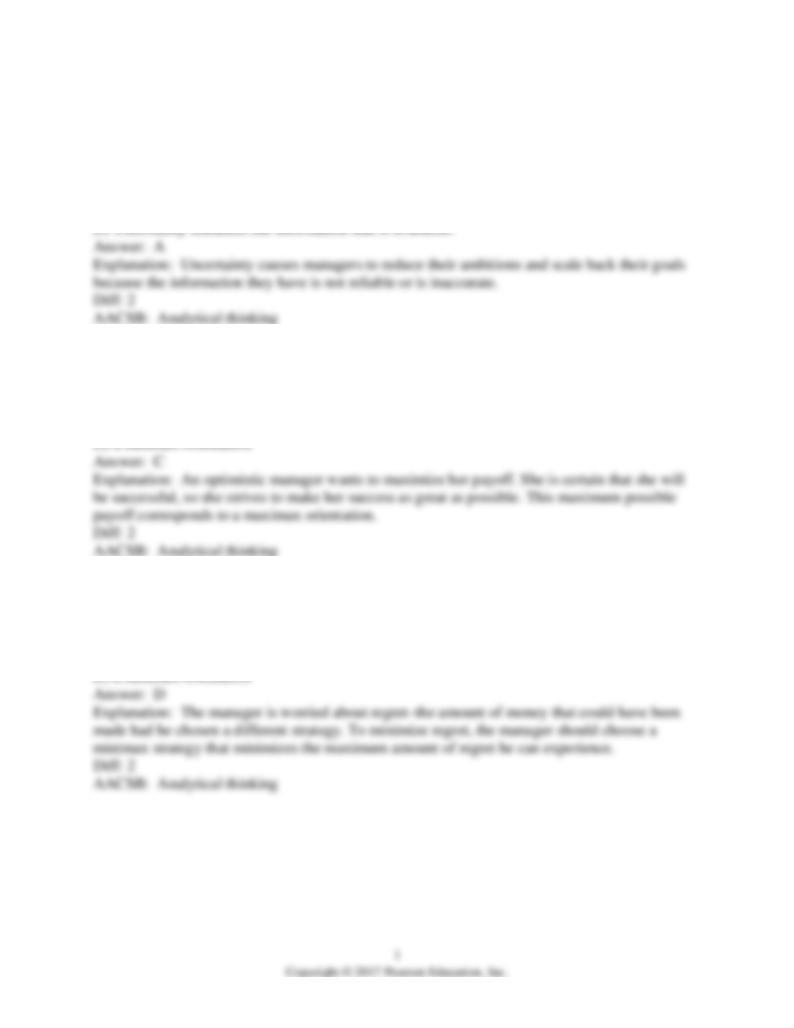
Fundamentals of Management, 10e (Robbins)
Chapter 4a Quantitative Module
1) Which role does uncertainty typically play in how managers function?
A) Uncertainty limits the amount of information that is available.
B) Uncertainty increases the amount of information that is available.
C) Uncertainty improves the quality of information that is available.
2) Which psychological orientation would be typical of a manager who is optimistic about her
business environment?
A) a maximin orientation
B) a minimin orientation
C) a maximax orientation
3) A manager is worried that if he chooses the wrong investment strategy, his company could
lose out on a great deal of money. Which strategy should he follow?
A) a maximax orientation
B) a minimin orientation
C) a maximin orientation
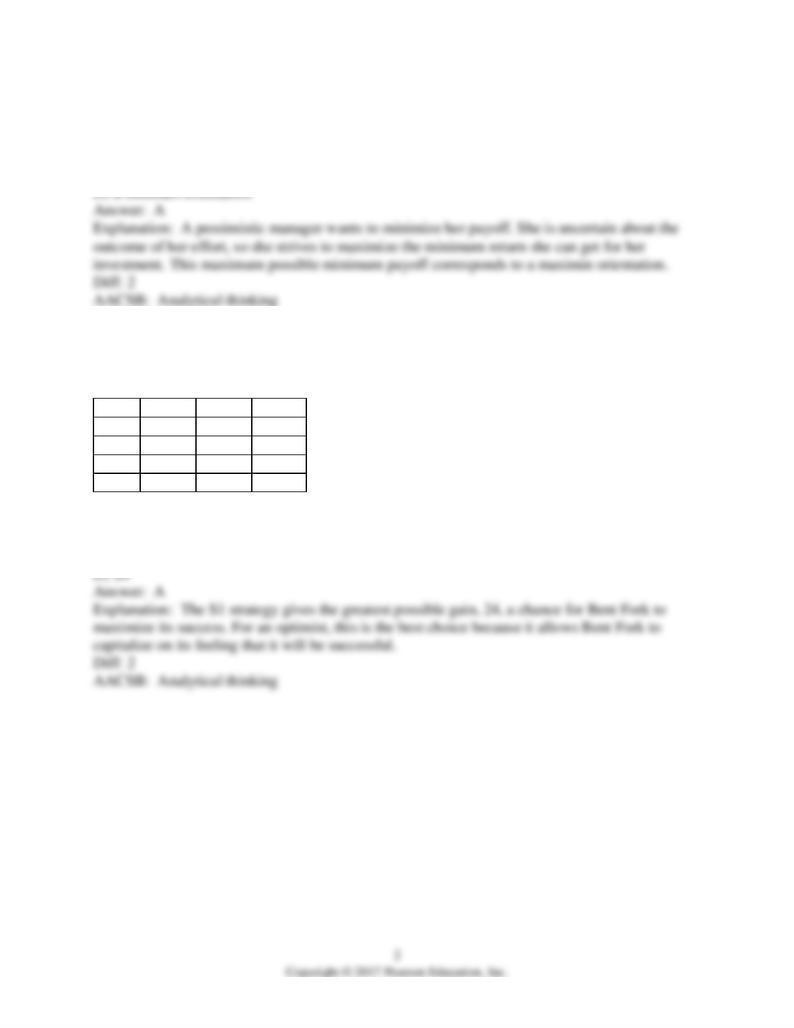
4) Which psychological orientation would be typical of a manager who is pessimistic about her
business environment?
A) a maximin orientation
B) a minimin orientation
C) a maximax orientation
5) This payoff matrix gives potential dollar gain values in millions for strategies S1, S2, S3, and
S4 for the Bent Fork National Bank and competitive strategies CA1, CA2, and CA3 for the
Straight Spoon Bank. If Bent Fork is optimistic, which strategy will it choose?
CA1 CA2 CA3
S1 3 24 17
S2 15 16 14
S3 8 19 10
S4 20 2 11
A) S1
B) S2
C) S3

6) This payoff matrix gives potential dollar gain values in millions for strategies S1, S2, S3, and
S4 for the Bent Fork National Bank and competitive strategies CA1, CA2, and CA3 for the
Straight Spoon Bank. If Bent Fork is pessimistic, which strategy will it choose?
CA1 CA2 CA3
S1 3 24 17
S2 15 16 14
S3 8 19 10
S4 20 2 11
A) S1
B) S2
C) S3
7) This payoff matrix gives potential dollar gain values in thousands for strategies S1, S2, S3,
and S4 for Sam's Pizza and competitive strategies CA1, CA2, and CA3 for Pam's Pizza. If Sam
chooses S4, how is he feeling about the business climate?
CA1 CA2 CA3
S1 13 14 7
S2 7 17 12
S3 31 29 4
S4 20 12 21
A) Sam is feeling optimistic because he has chosen a maximax strategy.
B) Sam is feeling pessimistic because he has chosen a maximin strategy.
C) Sam is feeling optimistic because he has chosen a maximin strategy.
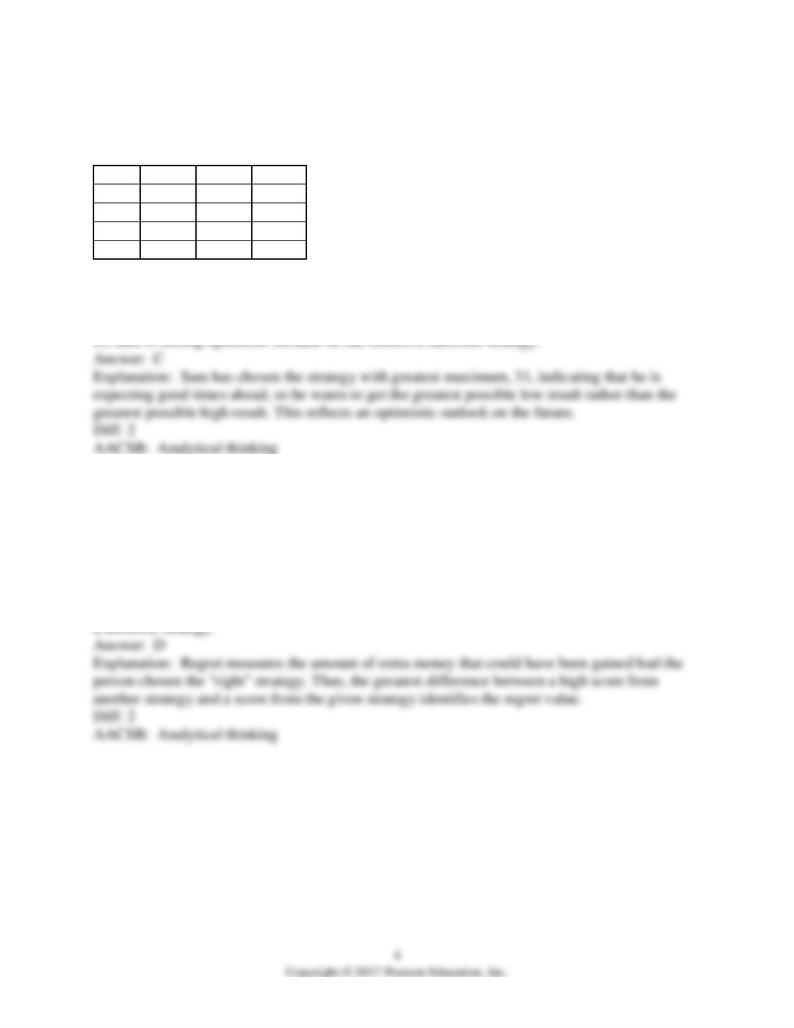
8) This payoff matrix gives potential dollar gain values in thousands for strategies S1, S2, S3,
and S4 for Sam's Pizza and competitive strategies CA1, CA2, and CA3 for Pam's Pizza. If Sam
chooses S3, how is he feeling about the business climate?
CA1 CA2 CA3
S1 13 14 7
S2 7 17 12
S3 31 29 4
S4 20 12 21
A) Sam is feeling pessimistic because he has chosen a maximax strategy.
B) Sam is feeling pessimistic because he has chosen a minimax strategy.
C) Sam is feeling optimistic because he has chosen a maximax strategy.
9) Which of the following best defines regret in a payoff matrix?
A) Regret refers to the difference of the sum of the values in a chosen strategy and the sum of the
best strategy.
B) Regret refers to the difference of the sum of the values in a chosen strategy and the sum of the
worst strategy.
C) Regret refers to the sum total of the sum of the values in a chosen strategy and the sum of the
best strategy.
D) Regret refers to the extra amount of money that could have been made had the person chosen

10) This payoff matrix gives potential dollar gain values in thousands for strategies S1, S2, S3,
and S4 for Sam's Pizza and competitive strategies CA1, CA2, and CA3 for Pam's Pizza. If Sam
chooses S1, how is he feeling about the business climate?
CA1 CA2 CA3
S1 13 14 7
S2 7 17 12
S3 31 29 4
S4 20 12 21
A) Sam is feeling pessimistic because he has chosen a maximax strategy.
B) Sam is feeling optimistic because he has chosen a maximin strategy.
C) Sam is feeling neither pessimistic nor optimistic because he has chosen neither a maximin nor
a maximax strategy.
D) Sam is feeling both pessimistic and optimistic because he has chosen both a maximin and a
11) This payoff matrix gives potential dollar gain values in thousands for strategies S1, S2, S3,
and S4 for Sam's Pizza and competitive strategies CA1, CA2, and CA3 for Pam's Pizza. What is
the maximum regret value for S1?
CA1 CA2 CA3
S1 13 14 7
S2 7 17 12
S3 31 29 4
S4 20 12 21
A) 18
B) 15
C) 14
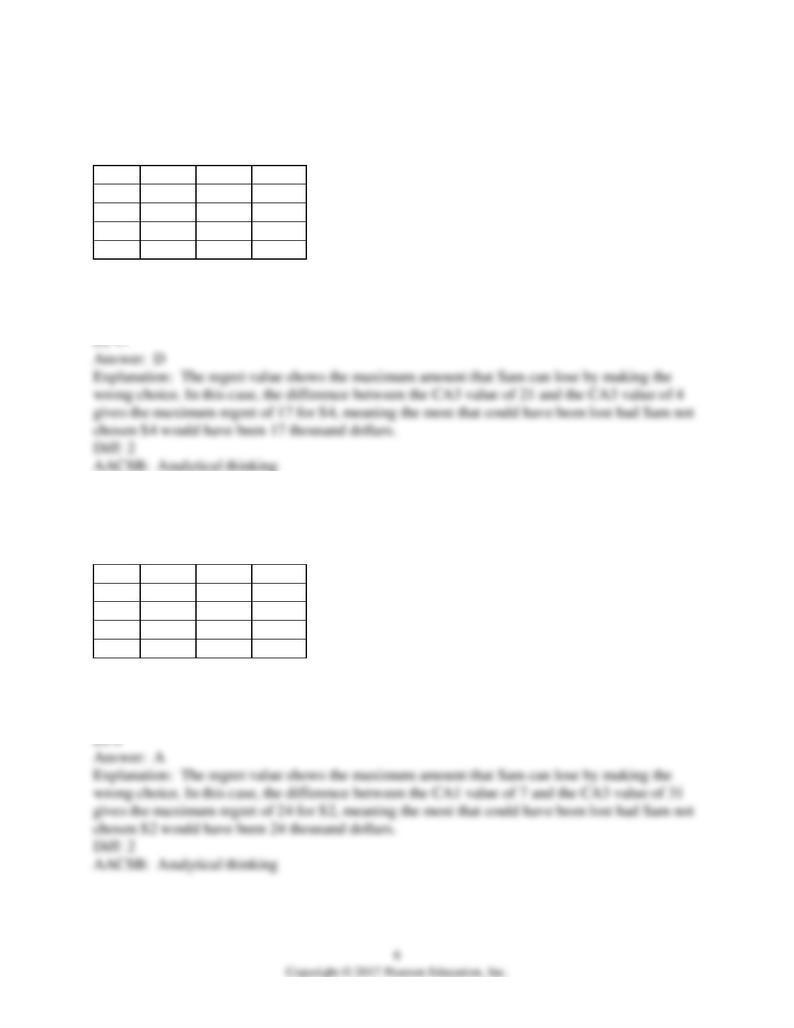
12) This payoff matrix gives potential dollar gain values in thousands for strategies S1, S2, S3,
and S4 for Sam's Pizza and competitive strategies CA1, CA2, and CA3 for Pam's Pizza. What is
the maximum regret value for S4?
CA1 CA2 CA3
S1 13 14 7
S2 7 17 12
S3 31 29 4
S4 20 12 21
A) 13
B) 7
C) 2
13) This payoff matrix gives potential dollar gain values in thousands for strategies S1, S2, S3,
and S4 for Sam's Pizza and competitive strategies CA1, CA2, and CA3 for Pam's Pizza. What is
the maximum regret value for S2?
CA1 CA2 CA3
S1 13 14 7
S2 7 17 12
S3 31 29 4
S4 20 12 21
A) 24
B) 15
C) 5
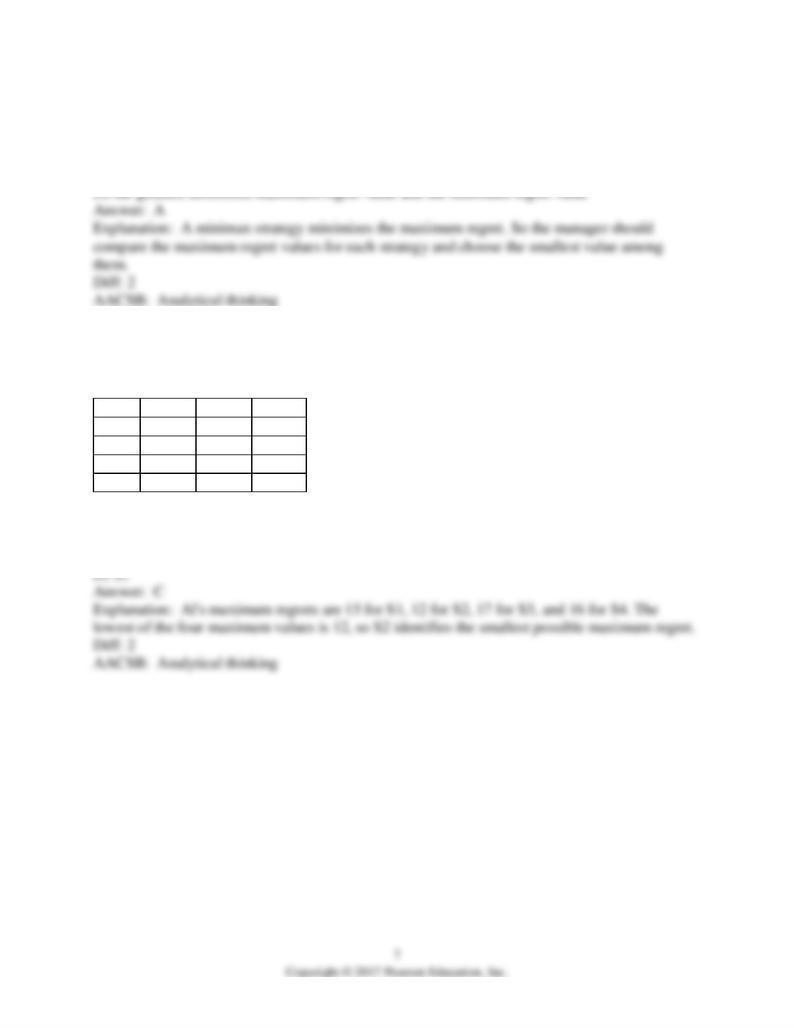
14) Which of the following would a manager who wants to minimize her maximum regret
choose?
A) the smallest maximum regret value
B) the smallest minimum regret value
C) the smallest difference maximum regret value and the minimum regret value
15) This regret matrix gives potential dollar values in thousands for strategies S1, S2, S3, and S4
for Al's Fish Fry and competitive strategies CA1, CA2, and CA3 for Sal's Fish Bake. If Al wants
to minimize his maximum regret, which strategy should he choose?
CA1 CA2 CA3
S1 3 15 9
S2 12 10 12
S3 8 9 17
S4 13 16 3
A) S4
B) S3
C) S2
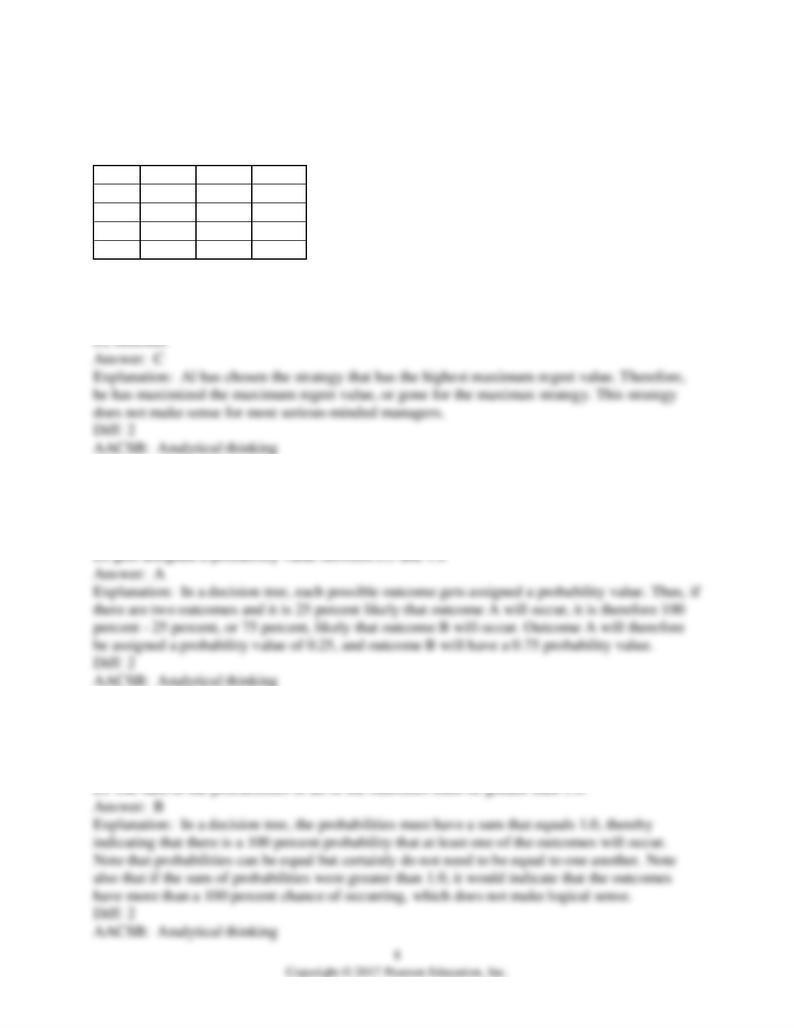
16) This regret matrix gives potential dollar values in thousands for strategies S1, S2, S3, and S4
for Al's Fish Fry and competitive strategies CA1, CA2, and CA3 for Sal's Fish Bake. If Al
chooses S3, what kind of strategy is he using?
CA1 CA2 CA3
S1 3 15 9
S2 12 10 12
S3 8 9 17
S4 13 16 3
A) minimax
B) maximin
C) maximax
17) In a decision tree, each possible outcome ________.
A) gets assigned a probability value between 0 and 1.0
B) gets assigned a probability value of 50 percent
C) gets assigned a probability value between 0 and 50 percent
18) In a decision tree, which of the following is true?
A) The probabilities of all of the outcomes must be equal.
B) The sum of the probabilities of all of the outcomes must equal 1.0.
C) No outcome can have a probability that is less to 1.0.

19) The decision tree shows the profit outcomes for a coffee shop in a strong and a weak
economy for next year. What is the probability that the economy will be weak in the coming
year?
A) 0.73
B) 27 percent
C) 50 percent

20) The decision tree shows the profit outcomes for a coffee shop in a strong and a weak
economy for next year. Suppose a third outcome is considered in which a moderate economy is
33 percent likely to occur. With this added outcome, how does the probability of a weak
economy change?
A) A weak economy is now 73 percent likely.
B) A weak economy is also 33 percent likely.
C) A weak economy is now 40 percent likely.
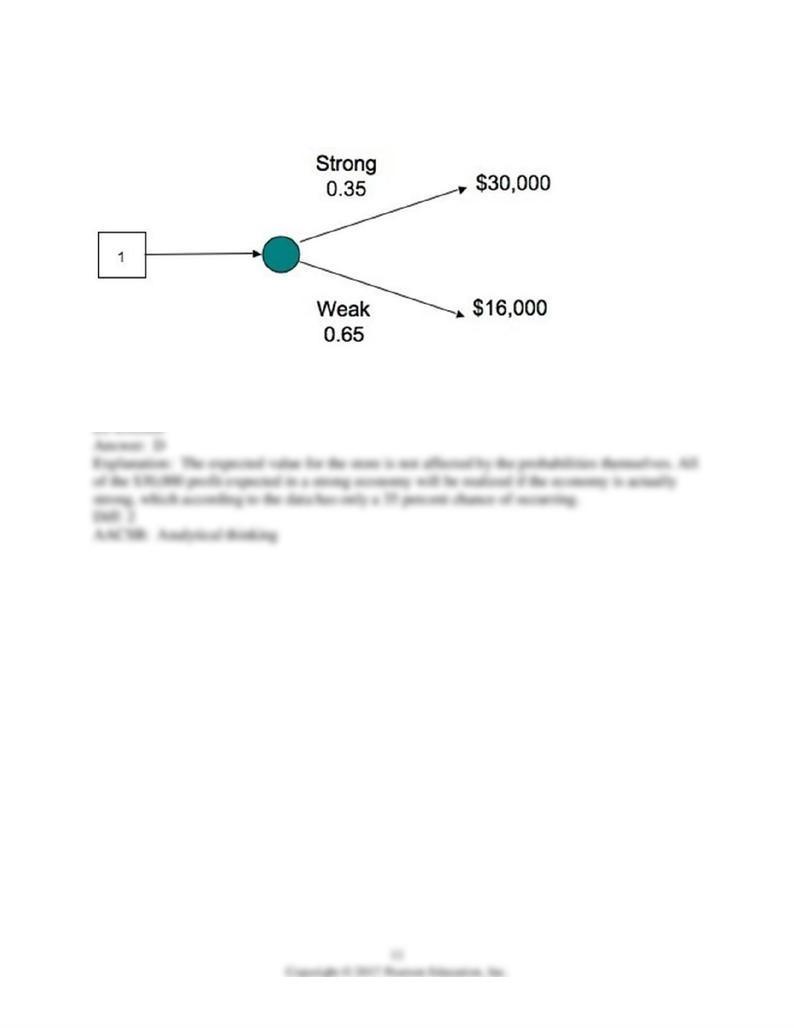
21) The decision tree shows the profit outcomes for a toy store in a strong and a weak economy
for next year. What is the expected value of the store's profit in a strong economy?
A) $10,500
B) $15,000
C) $16,000
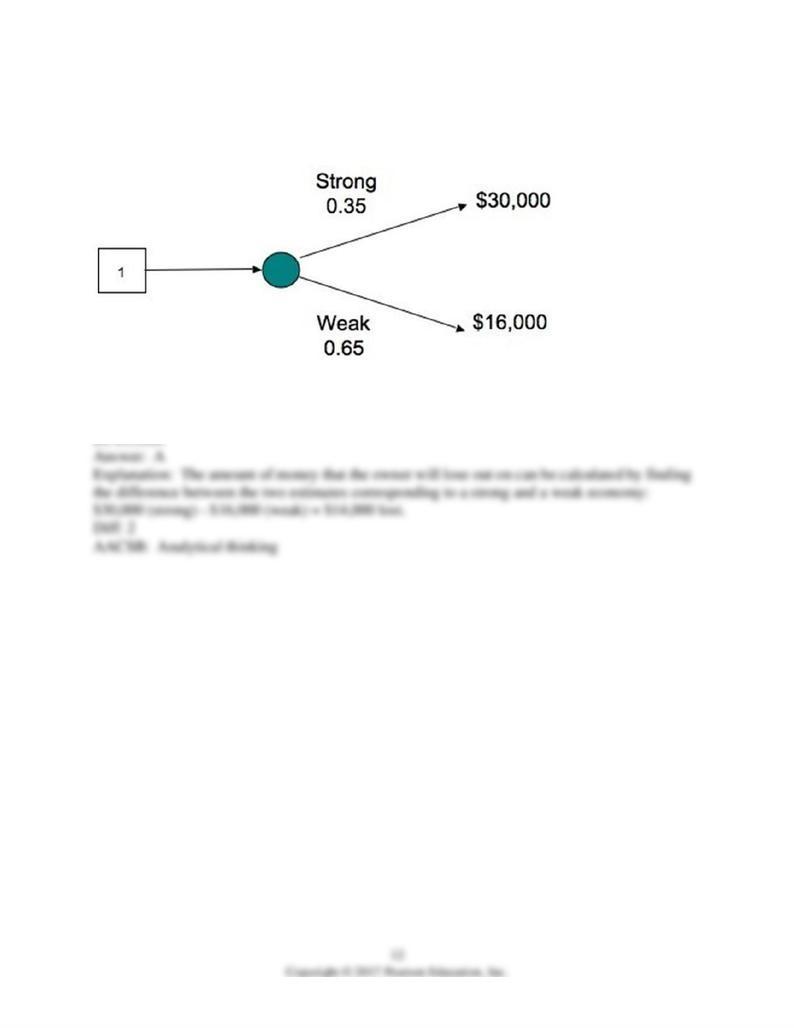
22) The decision tree shows the profit outcomes for a toy store in a strong and a weak economy
for next year. If the economy turns out to be weak, how much profit is the store likely to lose
out?
A) $14,000
B) $16,000
C) $30,000
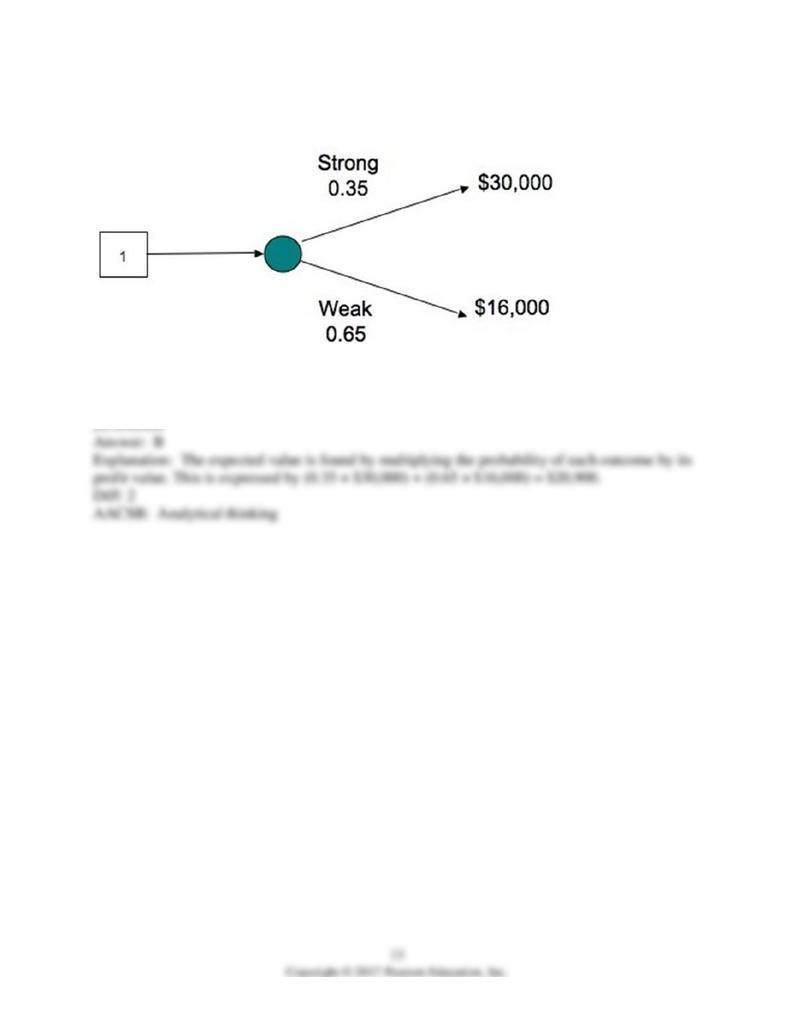
23) The decision tree shows the profit outcomes for a toy store in a strong and a weak economy
for next year. What is the expected value of profit for the store for the year?
A) $10,500
B) $20,900
C) $29,000
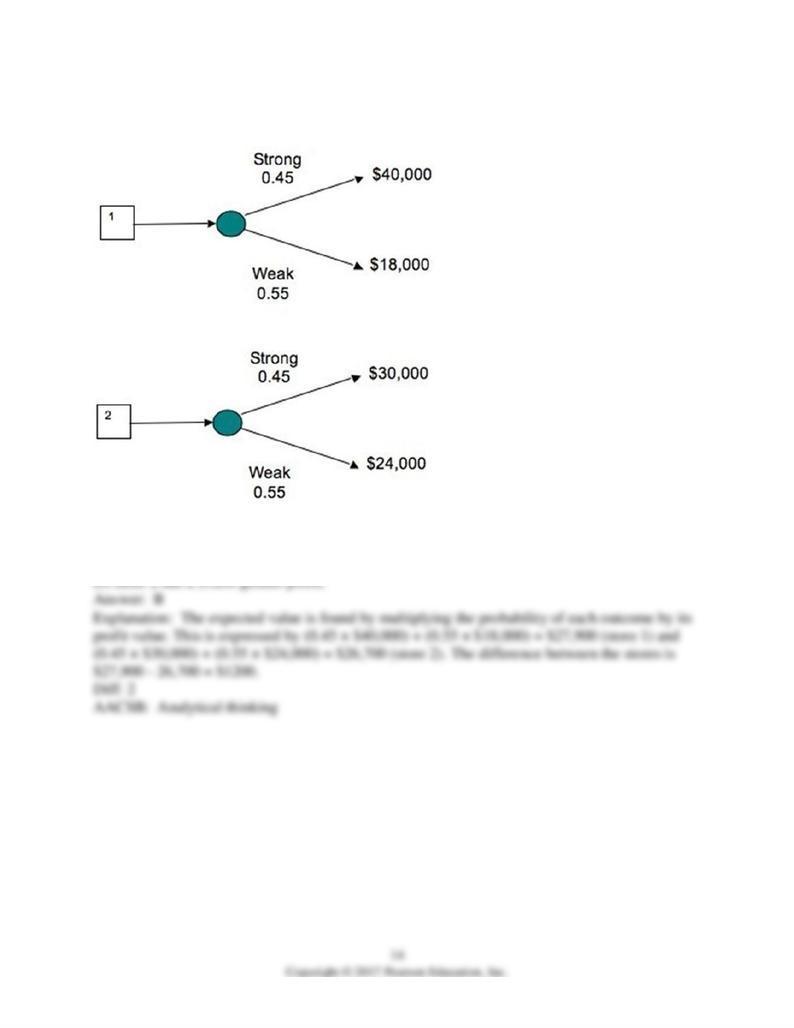
24) Decision trees show the profit outcomes for the plans for two doughnut stores in a strong and
a weak economy for the future. Which store is expected to have the greater expected profit?
A) Store 1 has a $27,900 greater profit.
B) Store 1 has a $1200 greater profit.
C) Store 2 has a $26,700 greater profit.
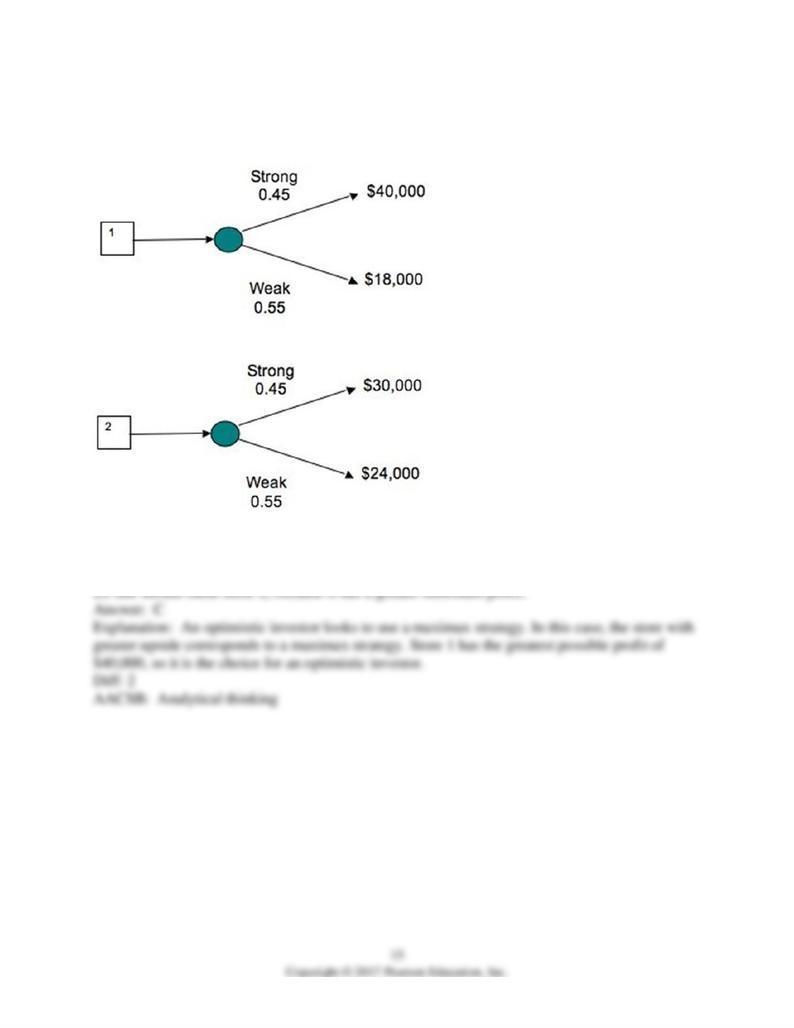
25) Decision trees show the profit outcomes for the plans for two doughnut stores in two
different locations in a strong and a weak economy for the future. If the investor interested in
building a store is optimistic, in which location should she build?
A) She should build Store 1, because it has a lower minimum profit.
B) She should build Store 2, because it has a greater maximum profit.
C) She should build Store 1, because it has a greater maximum profit.
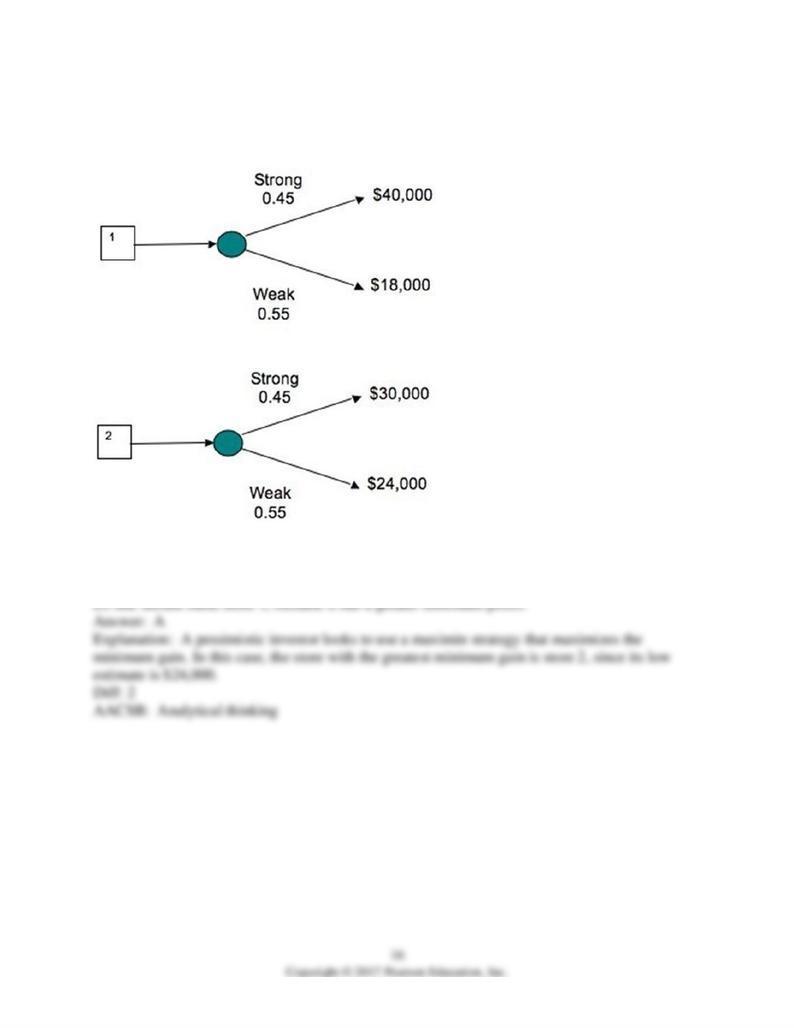
26) Decision trees show the profit outcomes for the plans for two doughnut stores in two
different locations in a strong and a weak economy for the future. If the investor interested in
building a store is pessimistic, in which location should she build?
A) She should build Store 2, because it has a greater minimum profit.
B) She should build Store 2, because it has a greater maximum profit.
C) She should build Store 1, because it has a greater maximum profit.
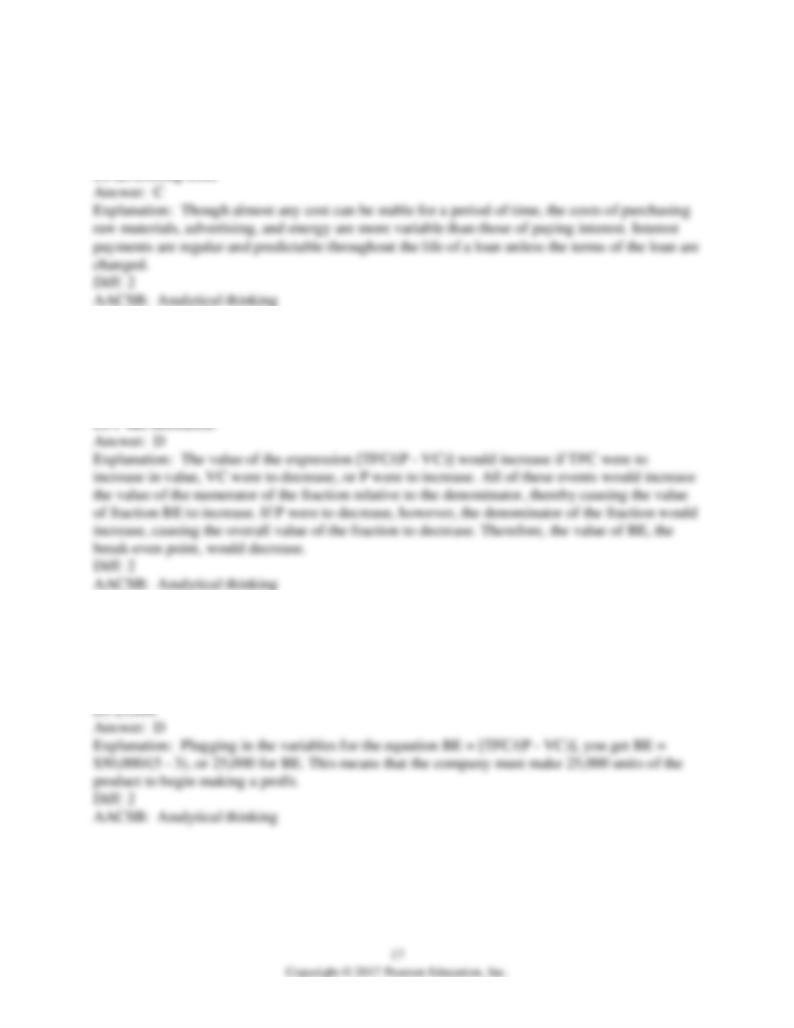
27) For break-even analysis, which of the following is a fixed cost for a doughnut shop?
A) costs for purchasing flour and sugar
B) energy costs for ovens and heating
C) interest payments on loans
28) A manager does a break-even analysis and finds that his value for BE, the break-even point,
has decreased over time. Which of the following could be responsible for this event?
A) TFC has increased.
B) P has increased.
C) VC has decreased.
29) Fixed costs for a product are $50,000. The product itself sells for $5.00 and it costs $3.00 to
make each product. What is the break-even point for the product?
A) 100,000
B) 10,000
C) 50,000
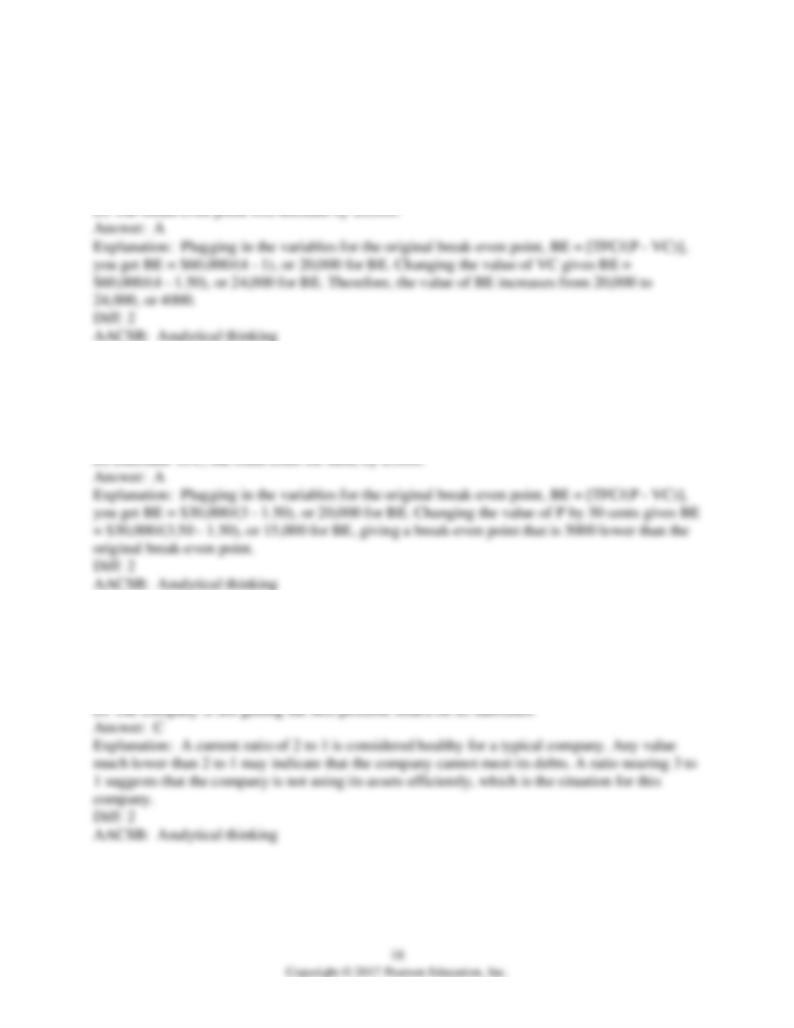
30) Fixed costs for a product are $60,000. The product itself sells for $4.00 and it costs $1.00 to
make each product. How will the break-even point for the product change if the variable cost per
unit goes up to $1.50?
A) The break-even point will increase by 4000.
B) The break-even point will increase by 24,000.
C) The break-even point will decrease by 4000.
31) Fixed costs for a product are $30,000. The product itself sells for $3.00 and it costs $1.50 to
make each product. How can the plant decrease the break-even point by 5000 units?
A) Increase P, the price of the item, by $0.50.
B) Increase TFC, the fixed costs for item, by $5000.
C) Decrease P, the price of the item, by $0.50.
32) A company has a current ratio of 2.75 to 1. What should a manager in the company
conclude?
A) The company is getting the best possible return on its assets.
B) The company has too many liabilities.
C) The company is not getting the best possible return on its assets.
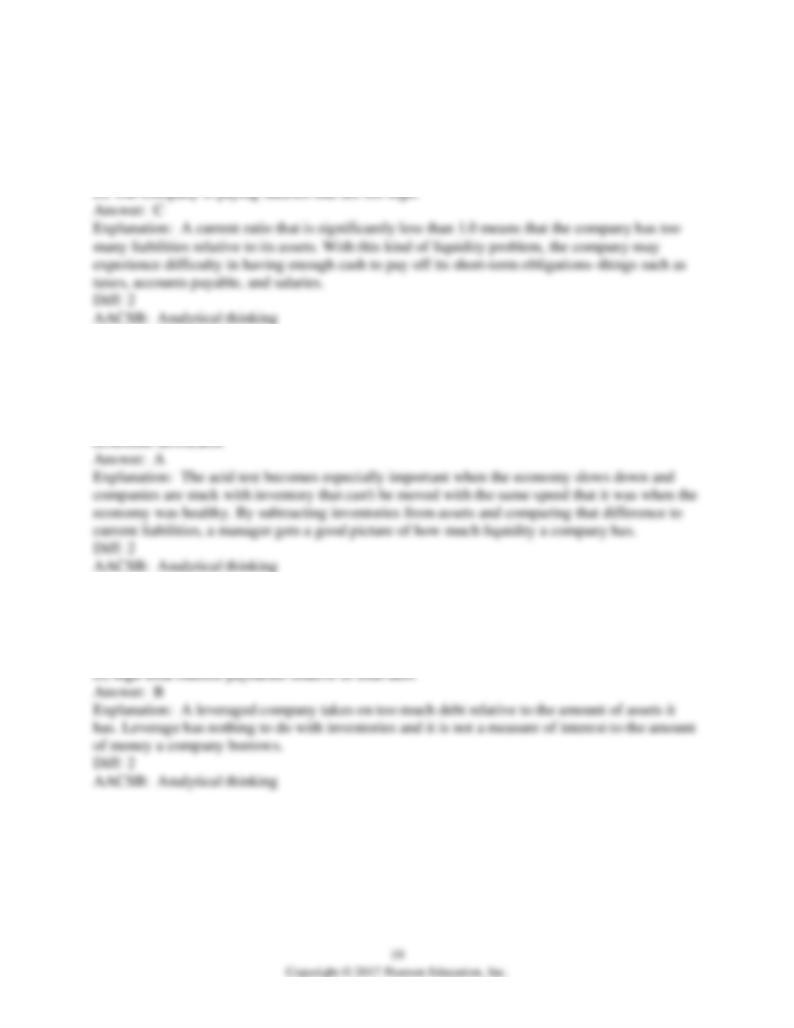
33) A company has a current ratio of 0.85 to 1. What should a manager in the company worry
about?
A) The company has too many assets and is not using them efficiently.
B) The company has too much inventory.
C) The company may start to have trouble paying salaries.
34) When is the acid test an especially important test for a company's liquidity?
A) when the economy is slow and inventory is not selling
B) when the economy is robust and inventory is selling fast
C) with companies that exclusively sell services and therefore do not have any inventory
D) with companies that exclusively sell services to the wealthy and therefore are not subject to
35) Which of the following characterizes a highly leveraged company?
A) high total assets relative to total debt
B) high total debt relative to total assets
C) high total debt relative to inventories
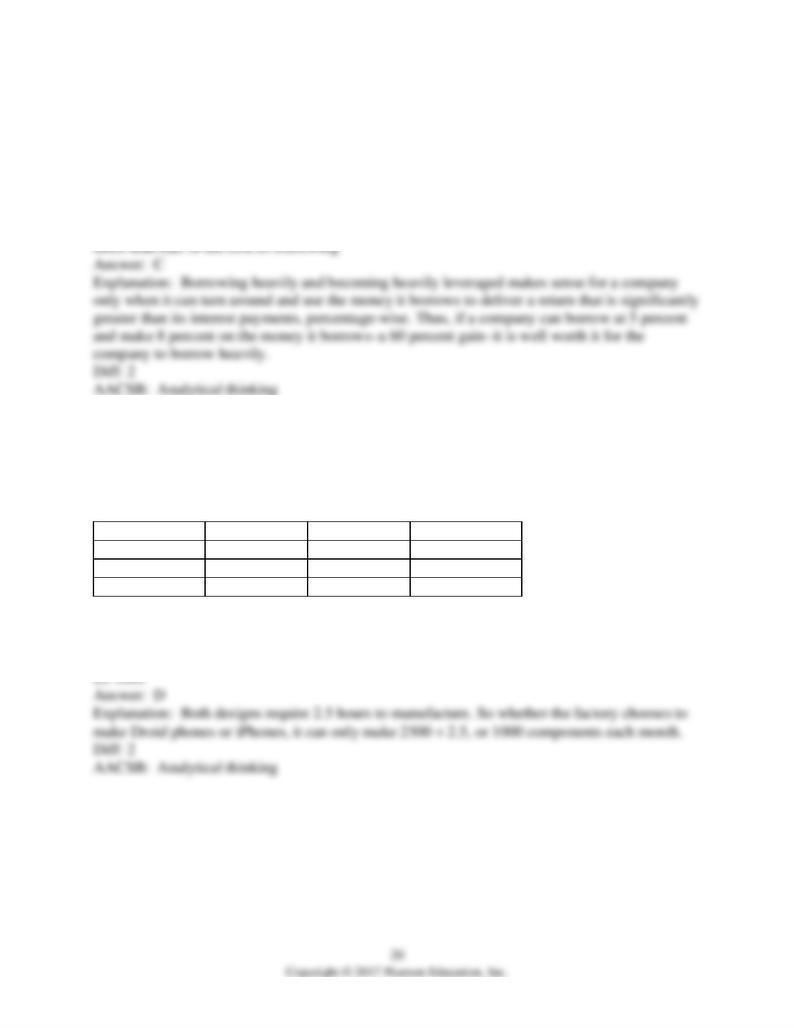
36) Which of the following would cause a well-run company to become highly leveraged?
A) when the money that the company can earn investing the money that it borrows is equal to the
cost of borrowing
B) when the money that the company can earn investing the money that it borrows is
significantly less than the cost of borrowing
C) when the money that the company can earn investing the money that it borrows is
significantly greater than the cost of borrowing
D) when the money that the company can earn investing the money that it borrows is equal to
37) Production data for the number of hours required per unit for making the Droid and iPhone
versions of cell phone components by Bizzer, a high-tech manufacturing firm, is given below.
What is the maximum number of units that the factory can make of either type of phone
component?
Monthly Product
Droid iPhone Capacity (Hours)
Design 5 8 5000
Manufacture 2.5 2.5 2500
Profit per unit $4 $6
A) 2500
B) 2000
C) 500
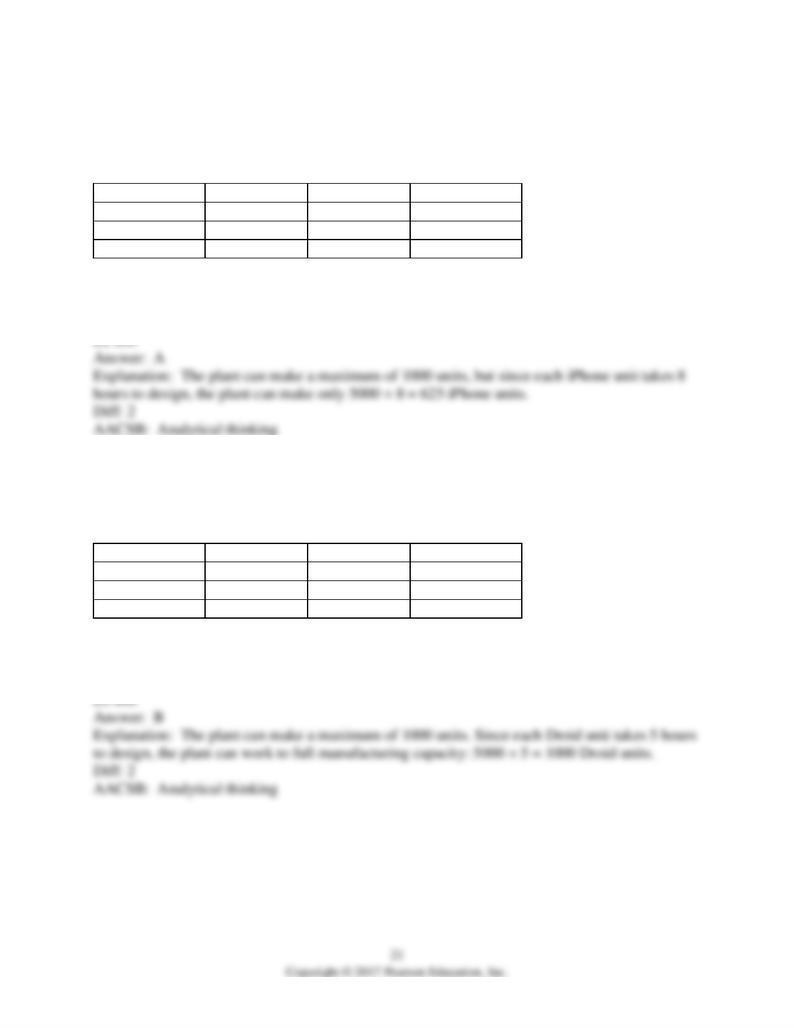
38) Production data for the number of hours required per unit for making the Droid and iPhone
versions of cell phone components by Bizzer, a high-tech manufacturing firm, is given below.
What is the maximum number of iPhone units that the factory can make?
Monthly Product
Droid iPhone Capacity (Hours)
Design 5 8 5000
Manufacture 2.5 2.5 2500
Profit per unit $4 $6
A) 625
B) 1000
C) 5000
39) Production data for the number of hours required per unit for making the Droid and iPhone
versions of cell phone components by Bizzer, a high-tech manufacturing firm, is given below.
What is the maximum number of Droid units that the factory can make?
Monthly Product
Droid iPhone Capacity (Hours)
Design 5 8 5000
Manufacture 2.5 2.5 2500
Profit per unit $4 $6
A) 625
B) 1000
C) 5000
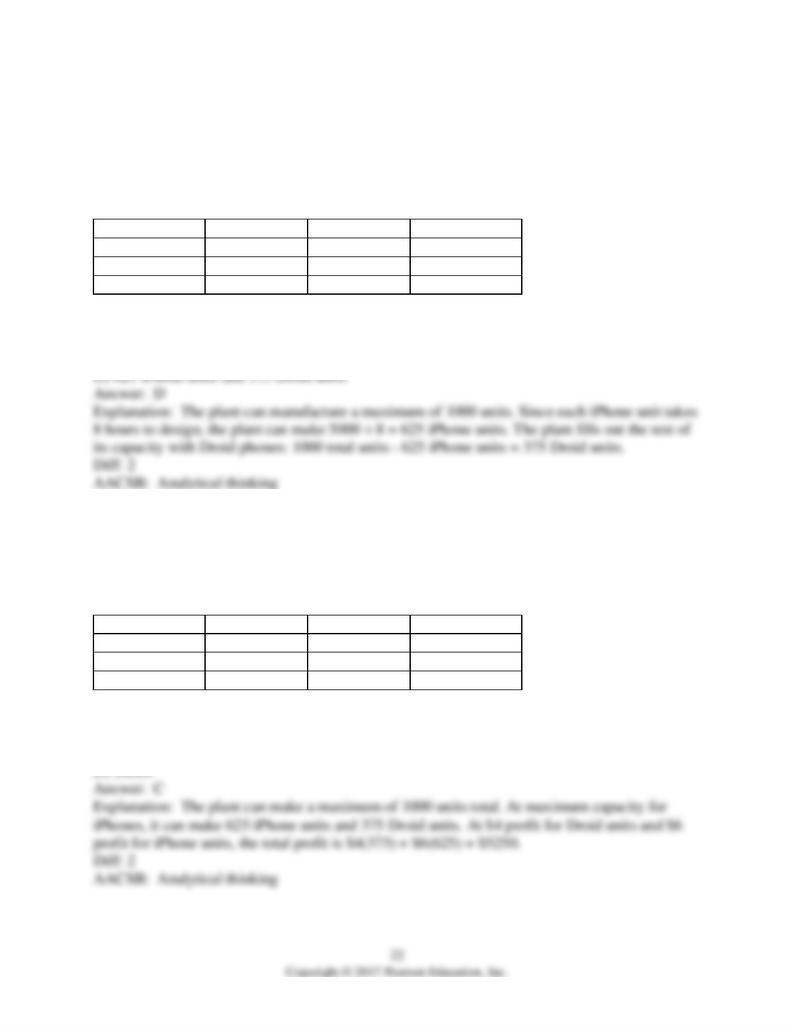
40) Production data for the number of hours required per unit for making the Droid and iPhone
versions of cell phone components by Bizzer, a high-tech manufacturing firm, is given below.
Suppose the plant decides to make the maximum number of iPhone components possible and
reach the rest of its capacity by making Droid phones. How many of each type of phone will it
make?
Monthly Product
Droid iPhone Capacity (Hours)
Design 5 8 5000
Manufacture 2.5 2.5 2500
Profit per unit $4 $6
A) 375 iPhone units and 625 Droid units
B) 500 iPhone units and 500 Droid units
C) 1000 iPhone units and 1000 Droid units
41) Production data for the number of hours required per unit for making the Droid and iPhone
versions of cell phone components by Bizzer, a high-tech manufacturing firm, is given below.
Suppose the plant decides to make the maximum number of iPhone components possible and
reach the rest of its capacity by making Droid phones. How much profit will it make?
Monthly Product
Droid iPhone Capacity (Hours)
Design 5 8 5000
Manufacture 2.5 2.5 2500
Profit per unit $4 $6
A) $3750
B) $1500
C) $5250
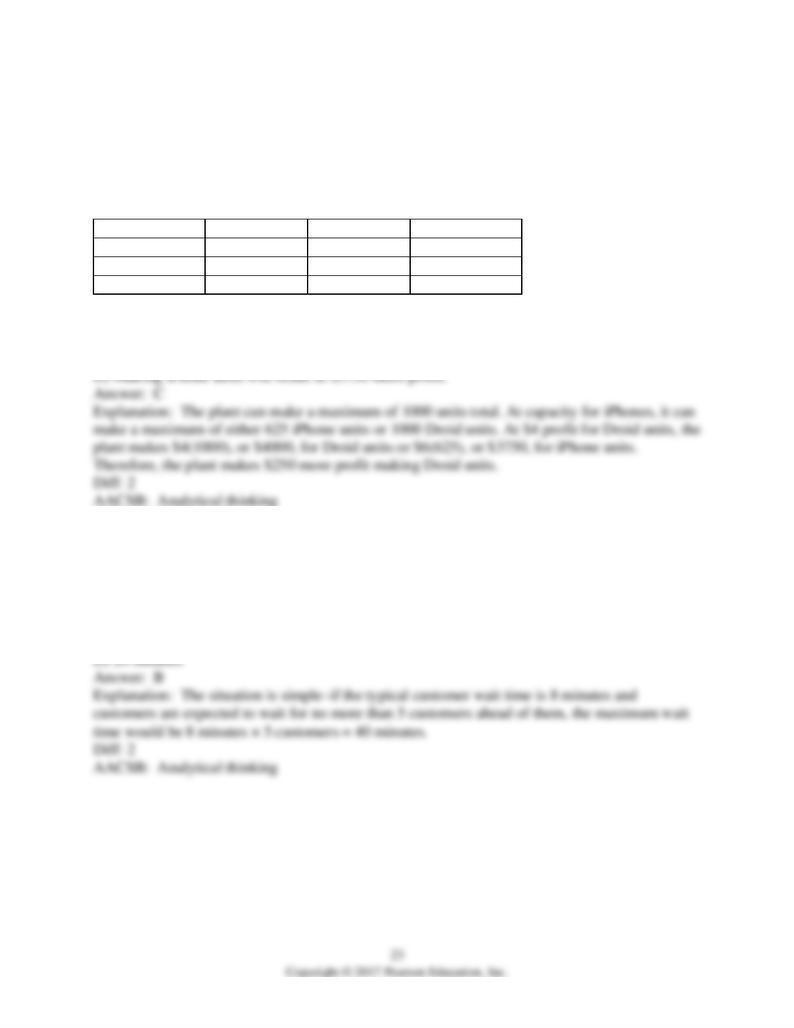
42) Production data for the number of hours required per unit for making the Droid and iPhone
versions of cell phone components by Bizzer, a high-tech manufacturing firm, is given below.
Suppose the plant decides exclusively to make either the maximum number of iPhone
components or the maximum number of Droid phones. Which choice will result in the greater
profit?
Monthly Product
Droid iPhone Capacity (Hours)
Design 5 8 5000
Manufacture 2.5 2.5 2500
Profit per unit $4 $6
A) Making Droid units will result in $4000 more profit.
B) Making iPhone units will result in $250 more profit.
C) Making Droid units will result in $250 more profit.
43) A queuing theory analysis for the Department of Motor Vehicles determines that customers
typically wait for 8 minutes and that the agency should strive never to exceed more than 5
customers in a single line. What is the maximum amount of time that customers should be
expected to wait?
A) 8 minutes
B) 40 minutes
C) 20 minutes

44) A queuing theory analysis for the Department of Motor Vehicles determines that customers
typically wait for 8 minutes and that the agency should strive never to exceed more than 5
customers in a single line. An analysis comes up with a value for P of 0.125. What does this P
value mean?
A) that customers will wait an average of 12.5 minutes
B) that the chances that a customer will need to wait for more than 5 people in line are 1 in 8
C) that customers will wait an average of 0.125 minutes
45) How does a fixed-point reordering system work?
A) When inventory level reaches 50 percent of maximum, the system orders new inventory.
B) When inventory level reaches 33 percent of maximum, the system orders new inventory.
C) At some preestablished inventory level, the system automatically orders new inventory.
46) Jeff, a manager at the Flux Soap Store, notices that the store regularly runs out of Jasmine-
Berry soap. Currently, the reorder point is fixed when inventory reaches 40 percent of maximum.
Which adjustment should Jeff make in a fixed-point reordering system?
A) Jeff should lower the reorder level to a point where inventory of Jasmine-Berry soap is at 30
percent of maximum.
B) Jeff should lower the reorder level to a point where inventory of Jasmine-Berry soap is at 10
percent of maximum.
C) Jeff should raise the reorder level to a point where inventory of Jasmine-Berry soap is at 50
percent of maximum.
D) Jeff should lower the reorder level to a point where inventory of Jasmine-Berry soap is at half
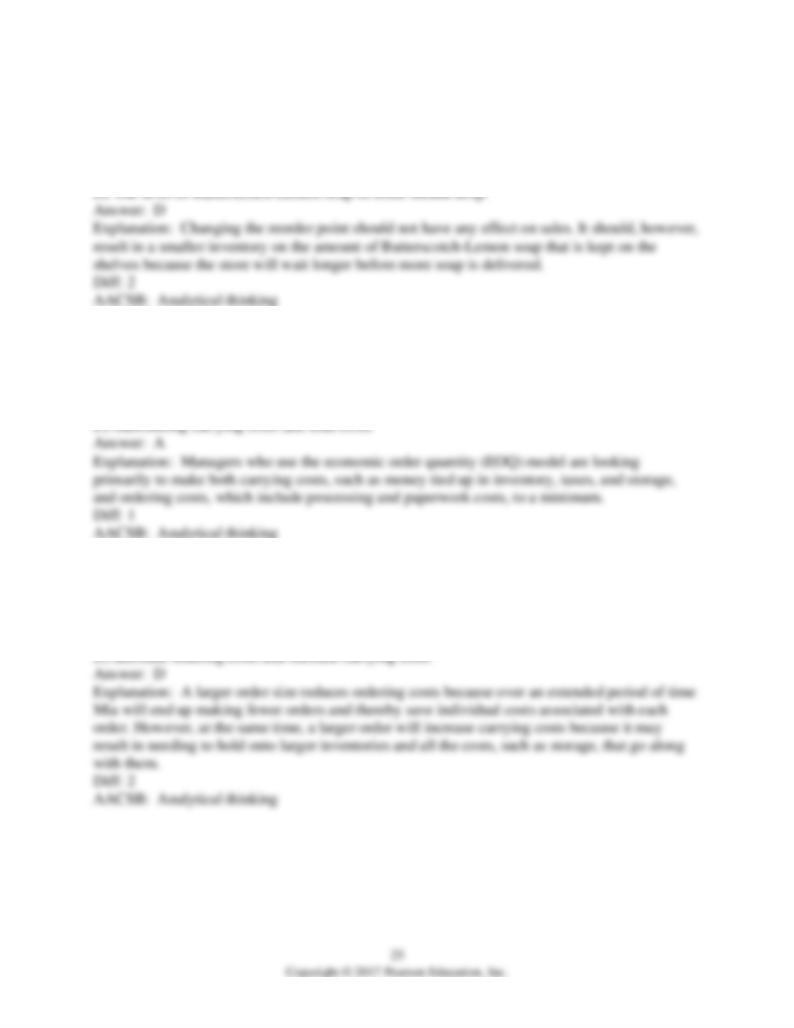
47) Jeff, a manager at the Flux Soap Store, lowered the reorder point for Butterscotch-Lemon
soap from 33 percent of maximum to 20 percent of maximum. What is Jeff likely to observe?
A) The level of Butterscotch-Lemon soap in stock should increase.
B) Sales of Butterscotch-Lemon soap should decrease.
C) Sales of Butterscotch-Lemon soap should increase.
48) Which of the following identifies the goal of managers who use the economic order quantity
(EOQ) model?
A) minimizing carrying costs and ordering costs
B) maximizing carrying costs and ordering costs
C) maximizing carrying costs and minimizing ordering costs
49) Mia, a manager at Best Buy, increases the order size for a product that the company sells,
which will ________.
A) increase both ordering costs and carrying costs
B) increase ordering costs and decrease carrying costs
C) decrease both ordering costs and carrying costs
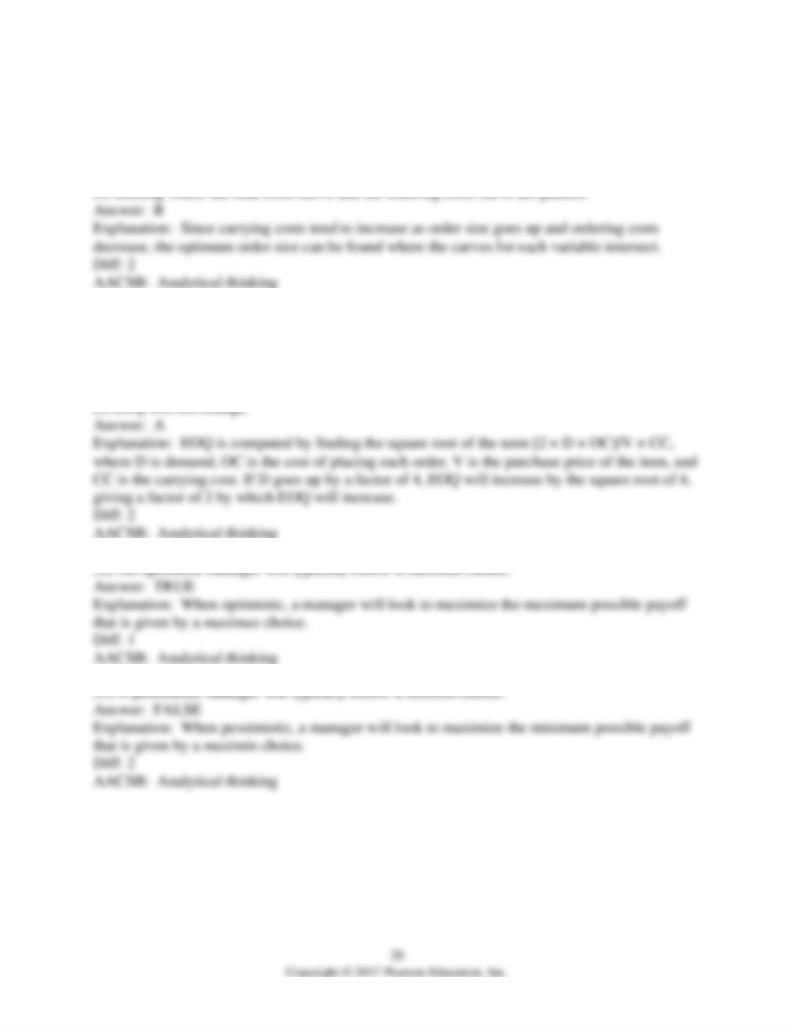
50) Mia, a manager at Best Buy, should be able to find Q, the most economic order size for a
product, by ________.
A) locating where the carrying costs curve and the total costs curve intersect
B) locating where the carrying costs curve and the ordering costs curve intersect
C) locating where the carrying costs curve and the ordering costs curve are parallel
51) A new upgrade for a product is expected to increase demand by a factor of 4. If all other
factors remain equal, how is EOQ likely to change?
A) EOQ will double.
B) EOQ will increase by 50 percent.
C) EOQ will decrease by 50 percent.
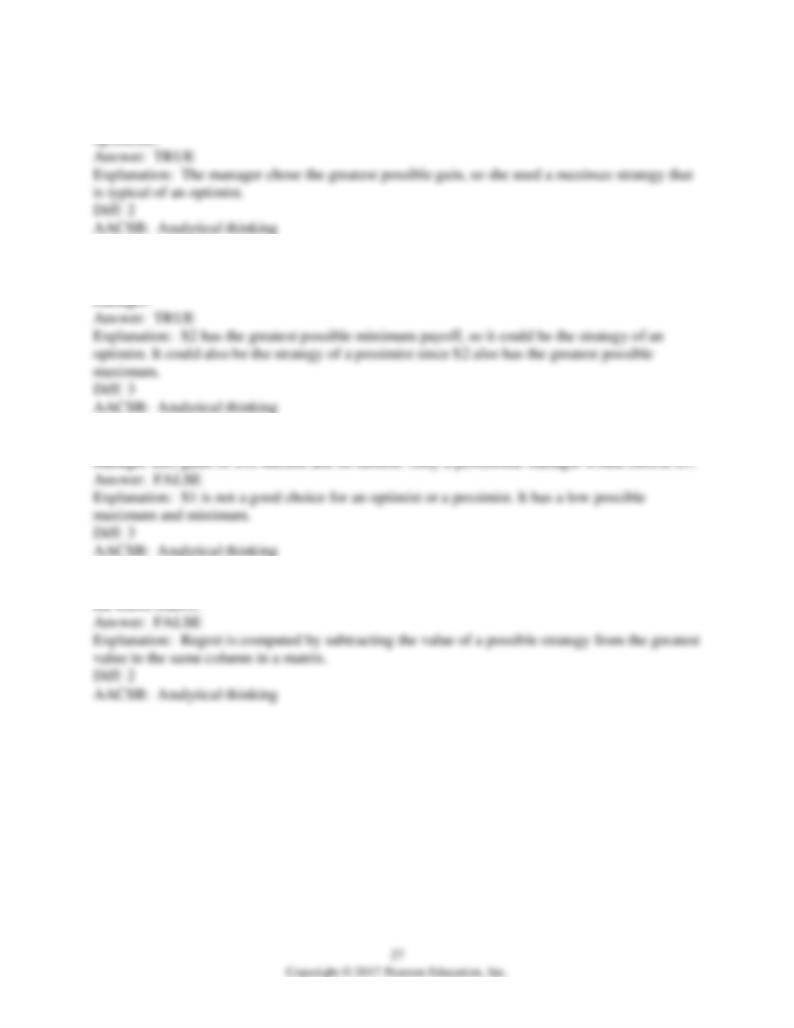
54) With choice S1, a manager sees gains of $10 million and $6 million. With choice S2, a
manager sees gains of $12 million and $3 million. The manager chooses S2, so she must be
55) With choice S1, a manager sees gains of $10 million and $6 million. With choice S2, a
manager sees gains of $12 million and $8 million. S2 might be the choice of a pessimistic
56) With choice S1, a manager sees gains of $10 million and $6 million. With choice S2, a
57) Regret is computed by subtracting the value of a possible strategy from the greatest value in
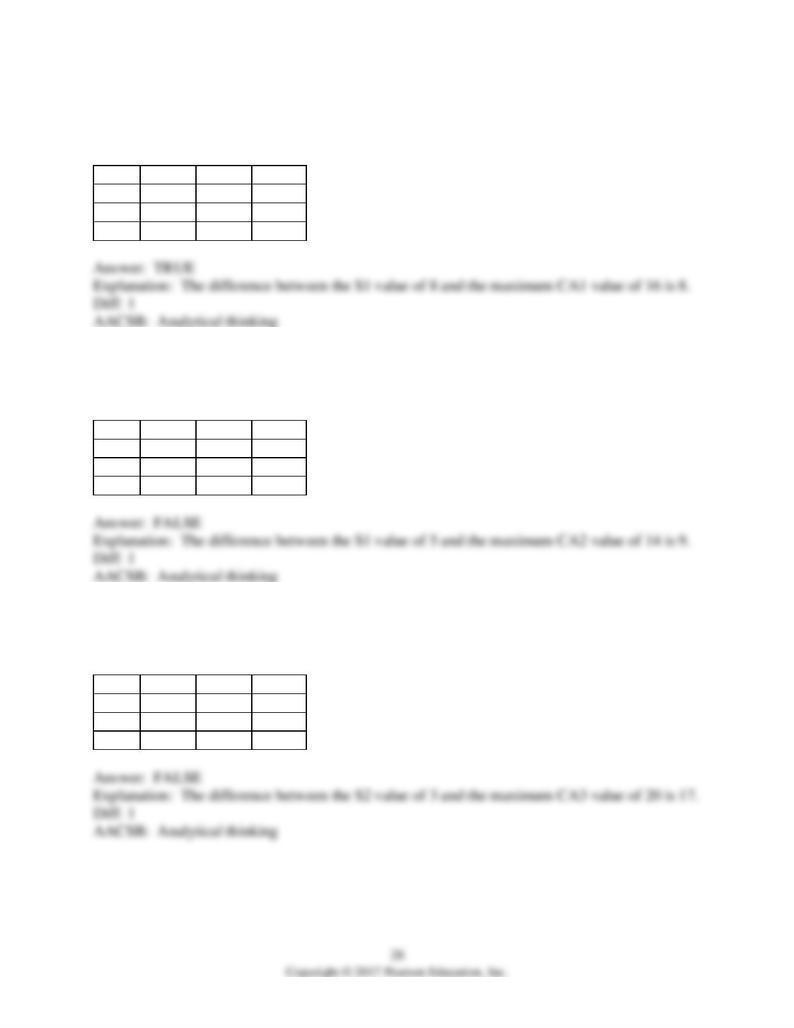
58) This payoff matrix gives values for strategies S1, S2, and S3 for the Bigg Company and
competitive strategies CA1, CA2, and CA3 for the Large Company. From Bigg's point of view,
the S1 maximum regret for CA1 is 8.
CA1 CA2 CA3
S1 8 5 12
S2 9 14 3
S3 16 13 20
59) This payoff matrix gives values for strategies S1, S2, and S3 for the Bigg Company and
competitive strategies CA1, CA2, and CA3 for the Large Company. From Bigg's point of view,
the S1 maximum regret for CA2 is 8.
CA1 CA2 CA3
S1 8 5 12
S2 9 14 3
S3 16 13 20
60) This payoff matrix gives values for strategies S1, S2, and S3 for the Bigg Company and
competitive strategies CA1, CA2, and CA3 for the Large Company. From Bigg's point of view,
the S2 maximum regret is 9.
CA1 CA2 CA3
S1 8 5 12
S2 9 14 3
S3 16 13 20
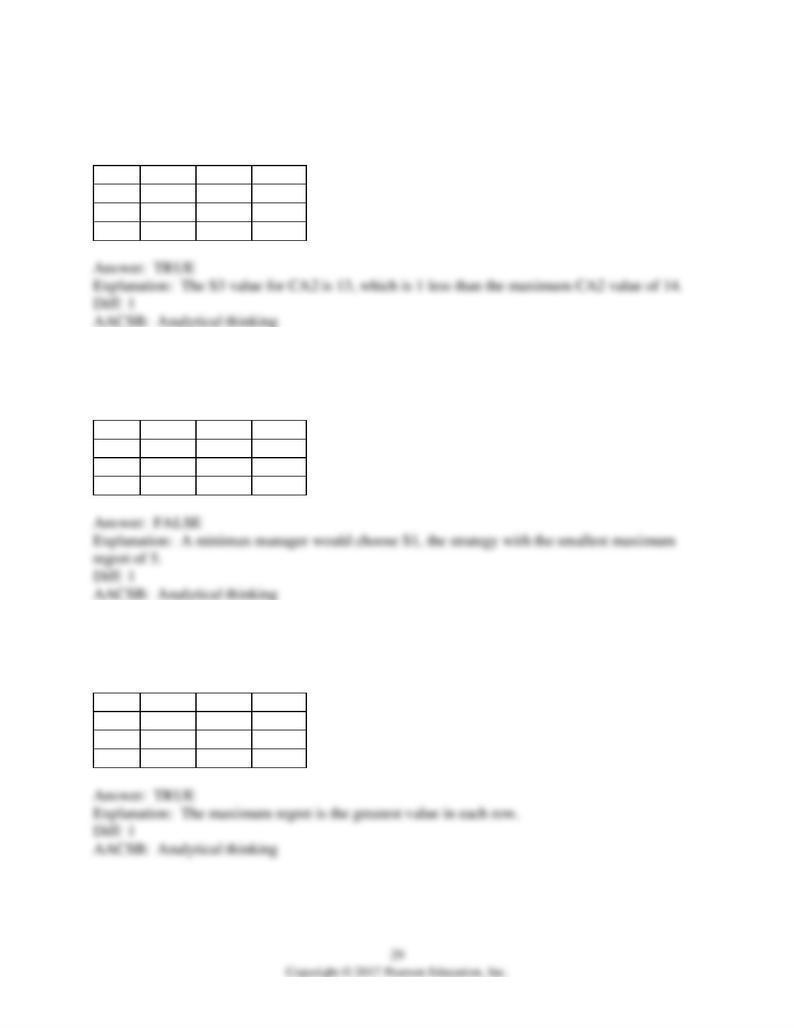
61) This payoff matrix gives values for strategies S1, S2, and S3 for the Bigg Company and
competitive strategies CA1, CA2, and CA3 for the Large Company. From Bigg's point of view,
the S3 maximum regret is 1.
CA1 CA2 CA3
S1 8 5 12
S2 9 14 3
S3 16 13 20
62) This regret matrix gives values for strategies S1, S2, and S3 for the Bigg Company and
competitive strategies CA1, CA2, and CA3 for the Large Company. A minimax Bigg manager
would choose S2 because it has the smallest maximum regret of 1.
CA1 CA2 CA3
S1 5 5 3
S2 9 6 1
S3 10 2 5
63) This regret matrix gives values for strategies S1, S2, and S3 for the Bigg Company and
competitive strategies CA1, CA2, and CA3 for the Large Company. The maximum regrets for
this table are S1 = 5, S2 = 9, S3 = 12.
CA1 CA2 CA3
S1 5 5 3
S2 9 6 1
S3 10 2 5
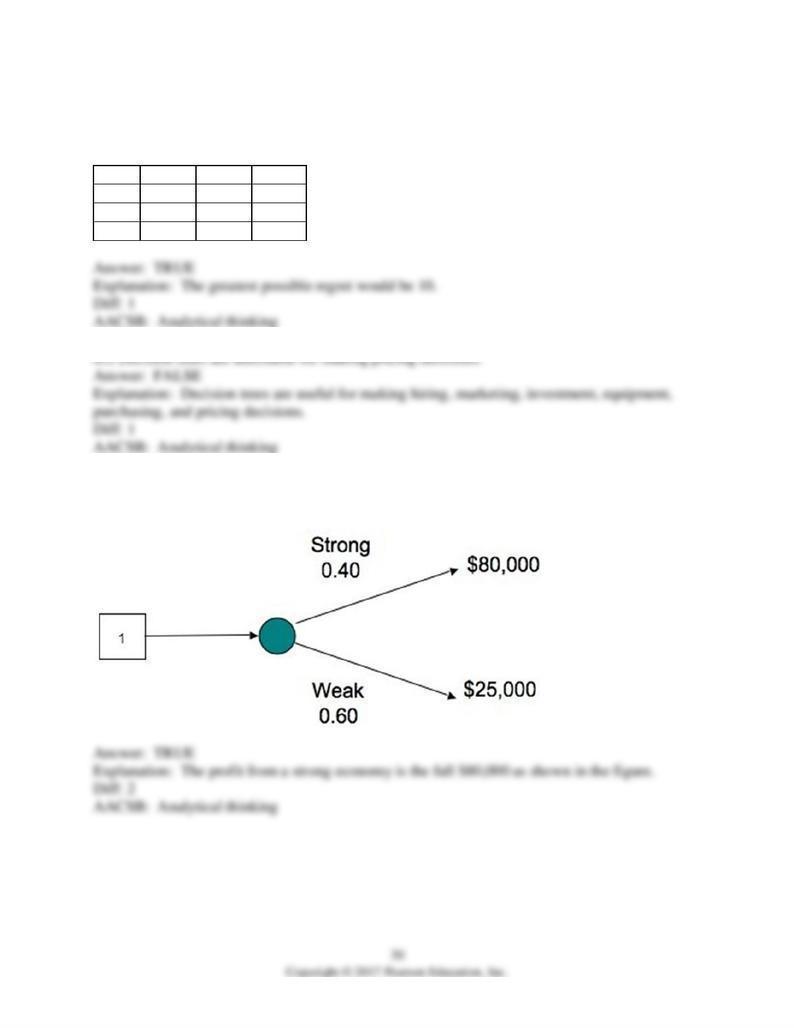
64) This regret matrix gives values for strategies S1, S2, and S3 for the Bigg Company and
competitive strategies CA1, CA2, and CA3 for the Large Company. A minimax Bigg manager
choosing S3 would have a greatest possible regret of 2.
CA1 CA2 CA3
S1 5 5 3
S2 9 6 1
S3 10 2 5
66) The decision tree shows the profit outcomes for a sandwich shop in a strong and a weak
economy. If the economy is strong, the shop is likely to make an $80,000 profit.
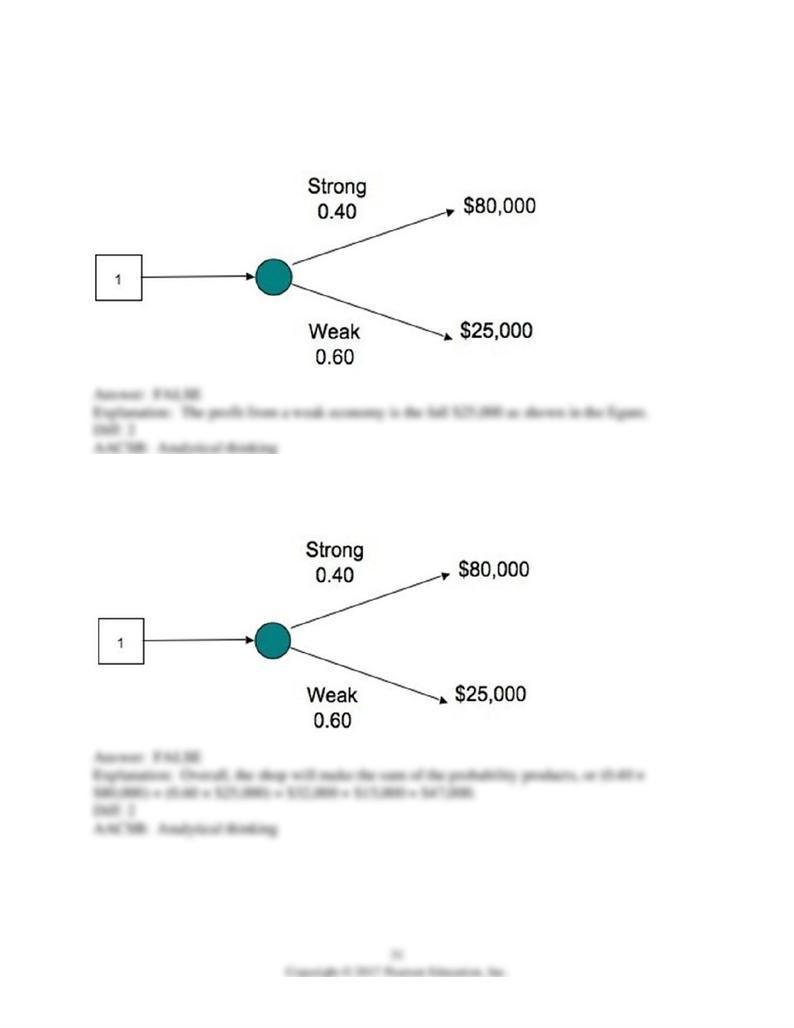
67) The decision tree shows the profit outcomes for a sandwich shop in a strong and a weak
economy. If the economy is weak, the shop is likely to make 60 percent of a $25,000 profit, or
$15,000.
68) The decision tree shows the profit outcomes for a sandwich shop in a strong and a weak
economy. Overall, the shop is expected to make $32,000.

69) The decision tree shows the profit outcomes for a sandwich shop in a strong and a weak
economy. The shop is likely to make $105,000, the sum of both projections.
70) A manager uses break-even analysis to find out how many units of a product he needs to sell
72) The greater the ratio of TFC to (P - VC) is means that the business needs to sell fewer units
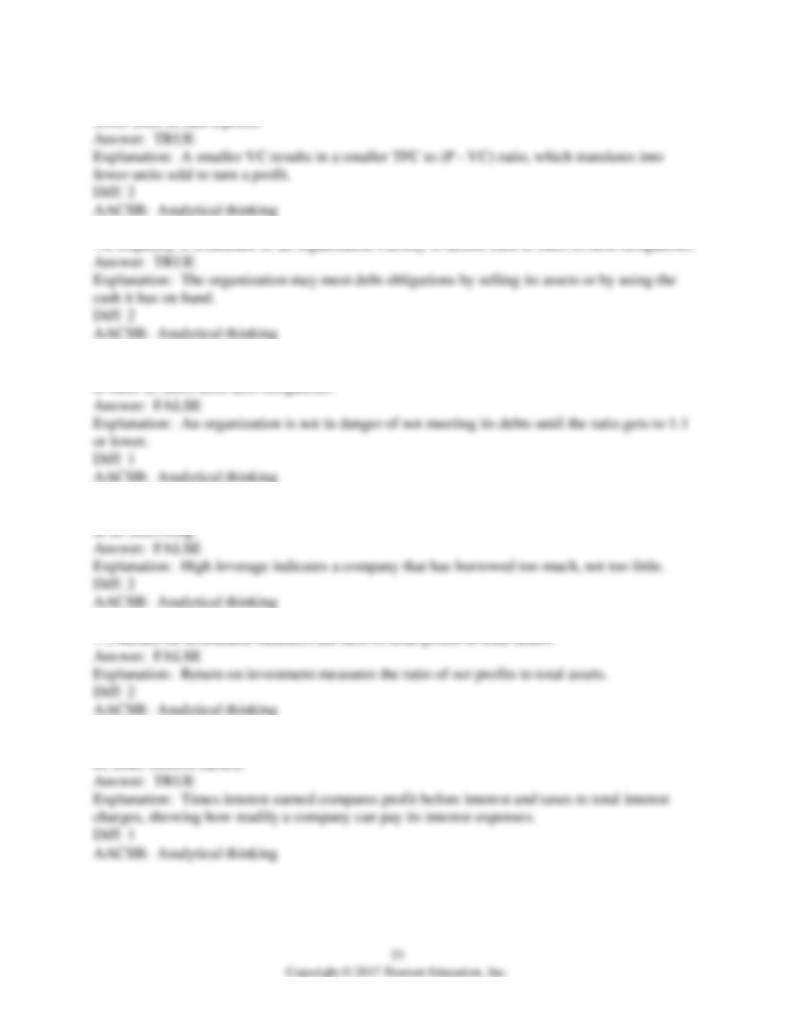
73) Reducing the value of VC in a break-even analysis means that the business needs to sell
75) A current ratio of 1.5 to 1 for an organization suggests that the organization will not be able
76) An organization with a high leverage ratio has usually been overly cautious and conservative
78) A company is worried about meeting its interest expenses, so it should pay close attention to
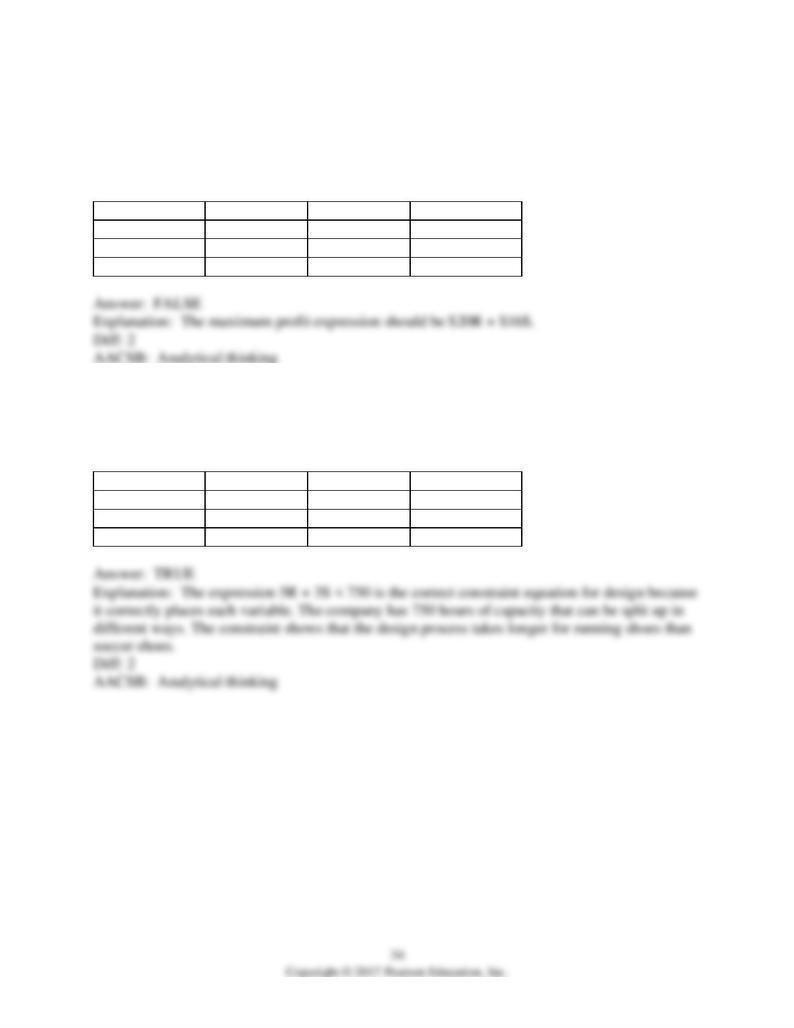
79) Production data is shown for the number of hours required per unit for the Running and
Soccer versions of Streaks, custom made athletic shoes. Using linear programming, if running
shoes are represented by R and soccer shoes by S, the expression $16R + $20S is equal to the
maximum profit that can be made.
Monthly Product
Running Soccer Capacity (Hours)
Design 5 3 750
Manufacture 1.5 1.5 300
Profit per unit $20 $16
80) Production data for Streaks is shown. Using linear programming, if running shoes are
represented by R and soccer shoes by S, 5R + 3S < 750 is the correct constraint equation for
design.
Monthly Product
Running Soccer Capacity (Hours)
Design 5 3 750
Manufacture 1.5 1.5 400
Profit per unit $20 $16

81) Production data for Streaks is shown. Using linear programming, the maximum number of
soccer shoes that the plant can make is 250.
Monthly Product
Running Soccer Capacity (Hours)
Design 5 3 750
Manufacture 1.5 1.5 400
Profit per unit $20 $16
82) Production data for Streaks is shown. Using linear programming, the maximum number of
running shoes that the plant can make is 250.
Monthly Product
Running Soccer Capacity (Hours)
Design 5 3 750
Manufacture 1.5 1.5 400
Profit per unit $20 $16
83) Production data for Streaks is shown. Using linear programming, if the plant makes 100 pairs
of running shoes and 100 pairs of soccer shoes, it ends up with $3600 in profit.
Monthly Product
Running Soccer Capacity (Hours)
Design 5 3 750
Manufacture 1.5 1.5 400
Profit per unit $20 $16
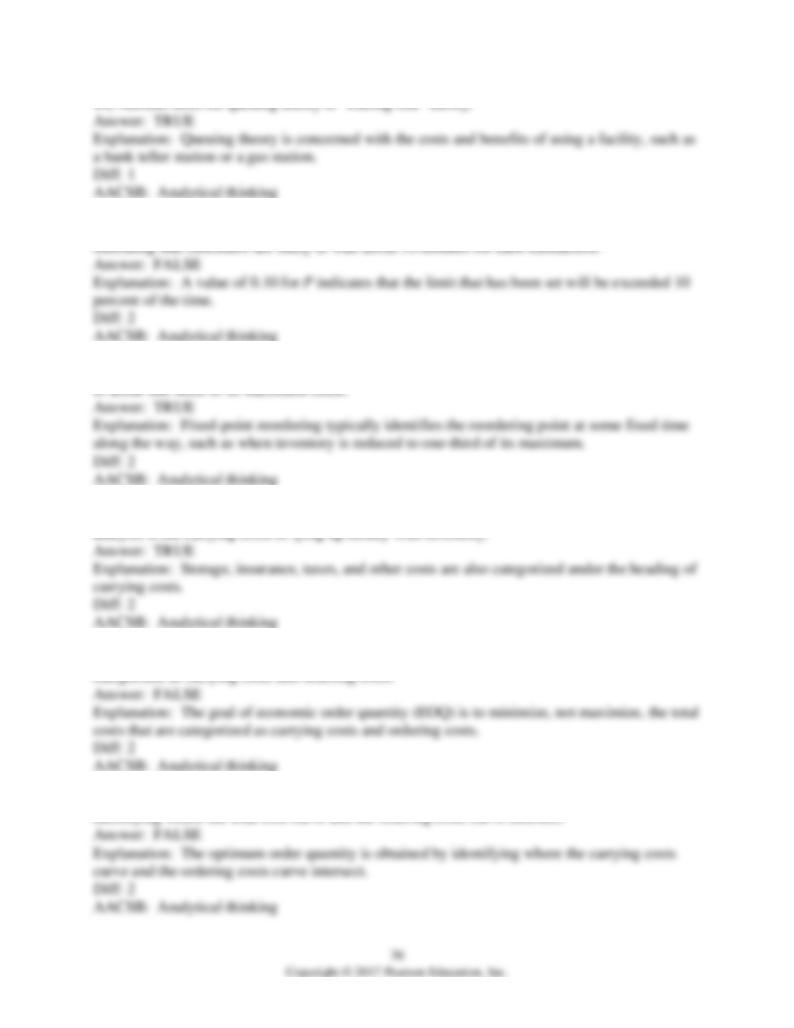
85) A queuing theory analysis for bank teller windows comes up with a value of 0.10 for P,
86) Using a fixed-point reordering system, a business might order new inventory when it is down
87) In the economic order quantity (EOQ) model, one of the costs that gets considered for
88) The goal of the economic order quantity (EOQ) model is to maximize the total costs that are
89) In the economic order quantity (EOQ) model, the optimum order quantity is obtained by
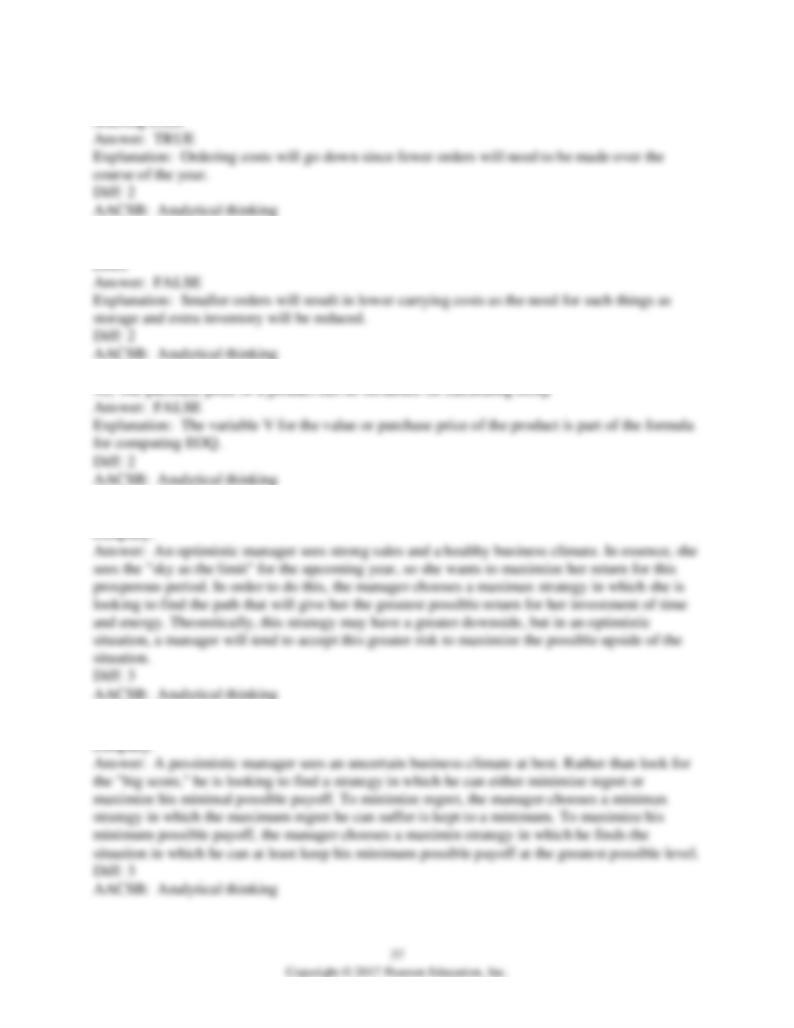
90) In the economic order quantity (EOQ) model, increasing the order size will decrease
91) In the economic order quantity (EOQ) model, decreasing the order size will increase carrying
93) In a short essay, explain the type of strategy that an optimistic manager would take for her
94) In a short essay, explain the type of strategy that a pessimistic manager would take for his
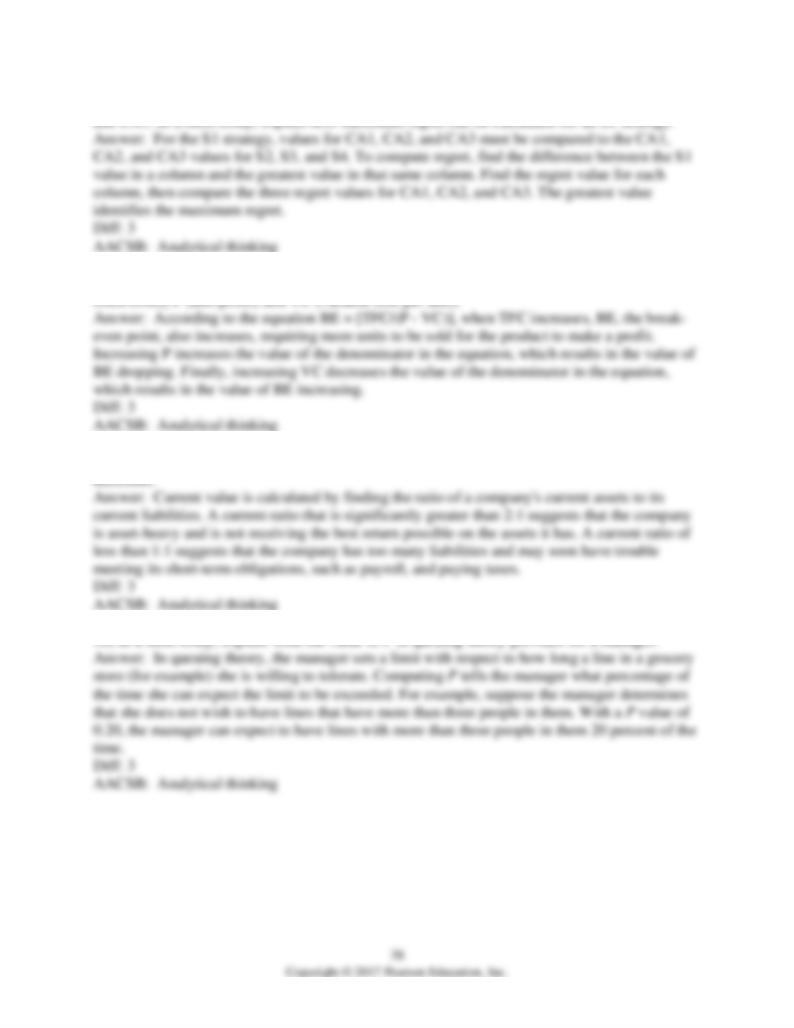
95) A payoff matrix features strategies S1, S2, S3, and S4 and competitive strategies CA1, CA2,
96) In a short essay, explain how the break-even point (BE) changes with variables TFC (total
97) In a short essay, explain how managers can use current value for making organizational
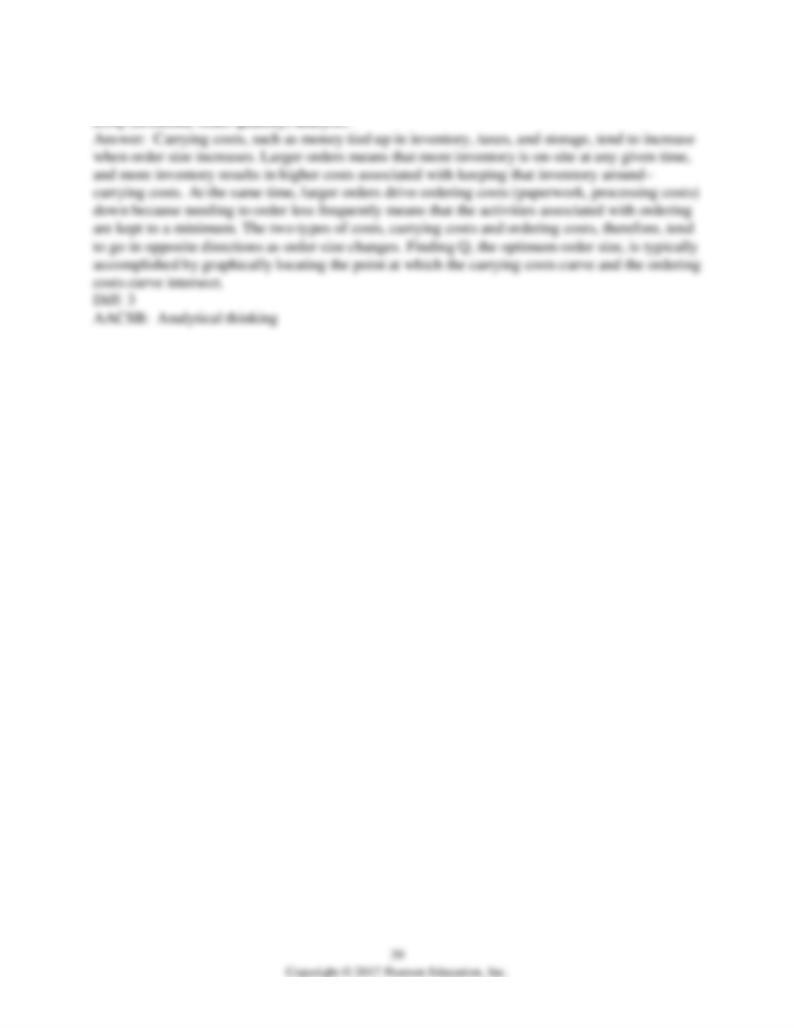
99) In a short essay, explain how carrying costs and ordering costs change with order size in